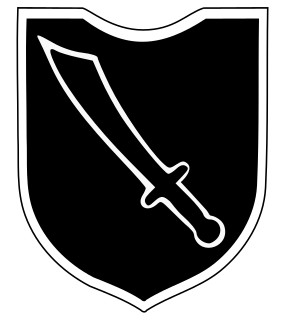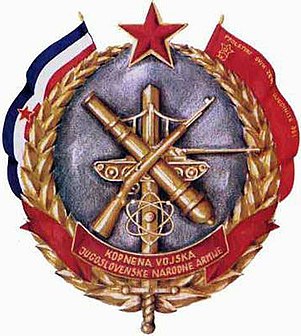Related Research Articles

The Yugoslav People's Army also called by some incorrectly the Yugoslav National Army, was the military of Yugoslavia from 1945 to 1992 and primary part of Yugoslavia armed forces.

The Yugoslav Partisans, or the National Liberation Army, officially the National Liberation Army and Partisan Detachments of Yugoslavia, was the Communist-led resistance to the Axis powers in occupied Yugoslavia during World War II.

Case Black, also known as the Fifth Enemy Offensive in Yugoslav historiography and often identified with its final phase, the Battle of the Sutjeska was a joint attack by the Axis taking place from 15 May to 16 June 1943, which aimed to destroy the main Yugoslav Partisan force, near the Sutjeska river in south-eastern Bosnia. The failure of the offensive marked a turning point for Yugoslavia during World War II.

The 13th Waffen Mountain Division of the SS "Handschar" was a mountain infantry division of the Waffen-SS, an armed branch of the German Nazi Party that served alongside but was never formally part of the Wehrmacht during World War II. From March to December 1944, it fought a counter-insurgency campaign against communist-led Yugoslav Partisan resistance forces in the Independent State of Croatia, a fascist puppet state of Germany that encompassed almost all of modern-day Croatia, all of modern-day Bosnia and Herzegovina as well as parts of Serbia. It was given the title Handschar after a local fighting knife or sword carried by Ottoman policemen during the centuries that the region was part of the Ottoman Empire. It was the first non-Germanic Waffen-SS division, and its formation marked the expansion of the Waffen-SS into a multi-ethnic military force. Composed of Bosnian Muslims with some Catholic Croat soldiers and mostly German and Yugoslav Volksdeutsche officers and non-commissioned officers, it took an oath of allegiance to both Adolf Hitler and the Croatian leader Ante Pavelić.

The Serbian Volunteer Corps, also known as Ljotićevci (Љотићевци) after their ideological leader Dimitrije Ljotić, was the party army of Zbor and collaborationist anti-Partisan military formation that was raised in the Territory of the Military Commander in Serbia during World War II. In July 1941, a full-scale rebellion by the communist Yugoslav Partisans and the royalist Chetniks erupted in the territory. The Germans pressured Milan Nedić's collaborationist government to deal with the uprisings under the threat of letting the armed forces of the Independent State of Croatia, Hungary, and Bulgaria occupy the territory and maintain peace and order in it. It was absorbed in the Waffen-SS in 1944 after evacuating to Slovenia, and in 1945 was rechristened the Serbian SS Corps
The Army of the Republic of Bosnia and Herzegovina, often referred to as Bosnian Army, was the military force of the Republic of Bosnia and Herzegovina established by the government of Bosnia and Herzegovina in 1992 following the outbreak of the Bosnian War. Following the end of the war, and the signing of the Dayton Peace Agreement in 1995, it was transformed into the Army of the Federation of Bosnia and Herzegovina. The ARBiH was the only military force on the territory of Bosnia and Herzegovina recognised as legal by other governments. Under the State Defense Reform Law the Armed Forces of Bosnia and Herzegovina were unified into a single structure, the Armed Forces of Bosnia and Herzegovina (OSBiH), making entity armies defunct.
The Russian Protective Corps was an armed force composed of anti-communist White Russian émigrés that was raised in the German occupied territory of Serbia during World War II. Commanded for almost its whole existence by Lieutenant General Boris Shteifon, it served primarily as a guard force for factories and mines between late 1941 and early 1944, initially as the "Separate Russian Corps" then Russian Factory Protective Group. It was incorporated into the Wehrmacht on 1 December 1942 and later clashed with the communist-led Yugoslav Partisans and briefly with the Chetniks. In late 1944, it fought against the Red Army during the Belgrade Offensive, later withdrawing to Bosnia and Slovenia as the Germans retreated from the Balkans. After Shteifon′s death in Zagreb, the Independent State of Croatia, on 30 April 1945, Russian Colonel Anatoly Rogozhin took over and led his troops farther north to surrender to the British in southern Austria. Unlike most other Russian formations that fought for Nazi Germany, Rogozhin and his men, who were not formally treated as Soviet citizens, were exempt from forced repatriation to the Soviet Union and were eventually set free and allowed to resettle in the West.

Military operations in World War II in Yugoslavia began on 6 April 1941, when the Kingdom of Yugoslavia was swiftly conquered by Axis forces and partitioned between Germany, Italy, Hungary, Bulgaria and client regimes. Subsequently, a guerrilla liberation war was fought against the Axis occupying forces and their locally established puppet regimes, including the fascist Independent State of Croatia and the Government of National Salvation in the German-occupied territory of Serbia, by the Communist-led republican Yugoslav Partisans. Simultaneously, a multi-side civil war was waged between the Yugoslav communist Partisans, the Serbian royalist Chetniks, the Croatian fascist Ustashe and Home Guard, Serbian Volunteer Corps and State Guard, as well as Slovene Home Guard troops.
The Battle of Lijevče Field was a battle fought between 30 March and 8 April 1945 between the Croatian Armed Forces and Chetnik forces on the Lijevče field near Banja Luka in what was then the Independent State of Croatia (NDH).
Army Group E was a German Army Group active during World War II.

This section is about the history of the Army of the Republic of Bosnia and Herzegovina that existed from 1992 to 1996, then it was formed into two armies of the two entities from 1998 to 2005 and finally transformed into the Armed Forces of Bosnia and Herzegovina (OSBIH).

The Belgrade Offensive or the Belgrade Strategic Offensive Operation was a military operation during World War II in Yugoslavia in which Belgrade was liberated from the German Wehrmacht through the joint efforts of the Soviet Red Army, Yugoslav Partisans, and the Bulgarian Army. Soviet forces and local militias launched separate but loosely cooperative operations that undermined German control of Belgrade and ultimately forced a retreat. Martial planning was coordinated evenly among command leaders, and the operation was largely enabled through tactical cooperation between Josip Broz Tito and Joseph Stalin that began in September 1944. These martial provisions allowed Bulgarian forces to engage in operations throughout Yugoslav territory, which furthered tactical success while increasing diplomatic friction.

The Yugoslav Ground Forces was the ground forces branch of the Yugoslav People's Army (JNA) from 1 March 1945 until 20 May 1992 when it became the Ground Forces of Serbia and Montenegro under the threat of sanctions.

The 8th Dalmatian Shock Corps was a corps of the Yugoslav Partisans formed on 7 October 1943. It was formed from the 9th, 19th, 20th, and 26th Dalmatian divisions. Upon creation it had 13,049 soldiers. The corps operated in the Independent State of Croatia, Governorate of Dalmatia, and Adriatic Littoral, where they fought Italians, Chetniks, the Ustaše, and Germans.
The Croatian Partisans, officially the National Liberation Movement in Croatia, were part of the anti-fascist National Liberational Movement in the Axis-occupied Yugoslavia which was the most effective anti-Nazi resistance movement led by Yugoslav revolutionary communists during the Second World War. NOP was under the leadership of the League of Communists of Yugoslavia (KPJ) and supported by many others, with Croatian Peasant Party members contributing to it significantly. NOP units were able to temporarily or permanently liberate large parts of Croatia from occupying forces. Based on the NOP, the Federal Republic of Croatia, which was referred to by Winston Churchill as "the Croatian miracle" was founded as a constituent of the Democratic Federal Yugoslavia.
The 4th Army of the Yugoslav Partisans was a Partisan army that operated in Yugoslavia during the last months of the Second World War.
The 3rd Army of the Yugoslav Partisans was a Partisan army that operated in Yugoslavia during the last months of the Second World War.
The 1st Army of the Yugoslav Partisans was a Partisan army that operated in Yugoslavia during the last months of the Second World War.
The 5th Bosnian Corps was a Yugoslav Partisan corps that fought against the Germans, Independent State of Croatia (NDH) and Chetniks in occupied Democratic Federal Yugoslavia during World War II.

The Sarajevo Operation was an operation by the Yugoslav Partisan Army which led to the liberation of Sarajevo and Central Bosnia in March-April 1945.